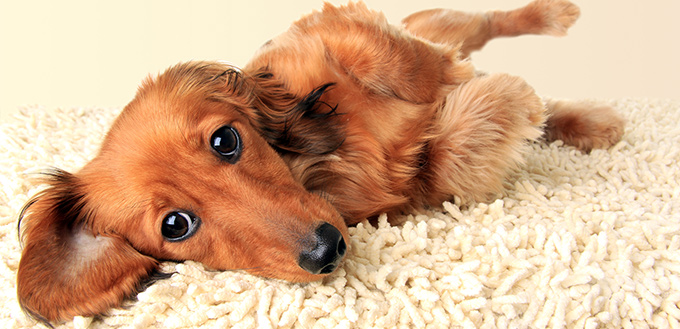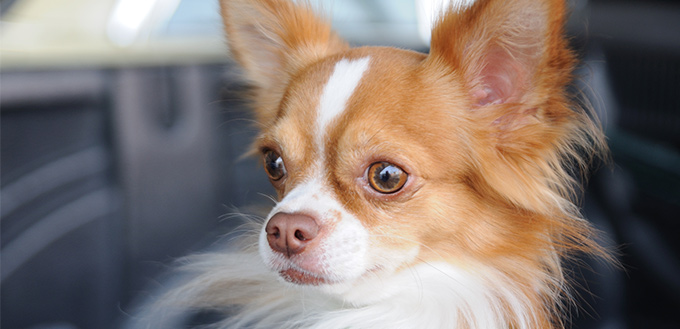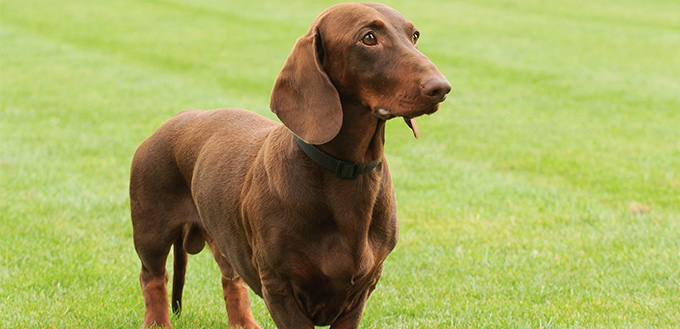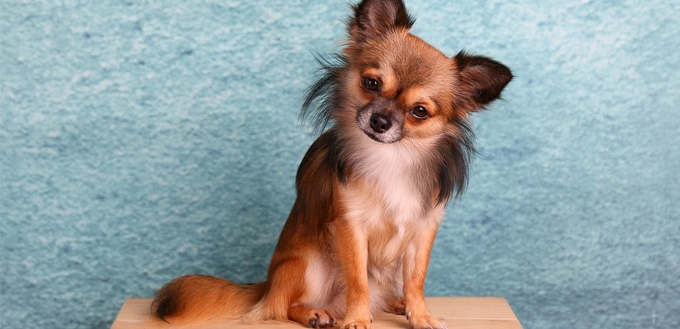It’s like the Finals of the World Cup where Germany meets Mexico for the title of the world’s cutest and most adorable little hound. Yet, the Chiweenie isn’t actually vying for individual honors as it proudly bears the rich history of its famous parents. Some call it the German Taco or the Mexican Hotdog, but the Chiweenie is anything but. Playful and outgoing as its parents with a rather stubborn streak yet equally devoted and courageous, the Chiweenie is what many dog designers call a match heaven made. But is this hybrid the right dog for you? Let’s find out.

History of the Chiweenie
Like all products of modern-day hybridization or crossbreeding, there is really not that much information as to the actual origin of this Chihuahua Dachshund Mix. This is quite unusual since crossbreeding is actually not new. It has been around for more than a century, stemming from the desire of some breeders to come up with a dog that meets their requirements for certain types of dogs. What is known is that the Chiweenie has been around since the early parts of the 20thcentury. However, it’s only in recent decades that its numbers are growing.
The idea of crossing a Dachshund with a Chihuahua makes perfect sense. The standard sized Chihuahua stands some 6 to 9 inches while the Dachshund is about the same maximum height at 9 inches. This alone makes for natural mating to occur without the need for artificial insemination which can pose quite a number of ethical issues. As such, it really doesn’t matter which of the two is the dam and which is the sire. However, in crossbreeding it is always the female breed that should be the larger of the two so that any genetic variations in the size of the litter can be successfully accommodated in the dog with a larger uterus. This also allows for the more efficient development of the litter through the gestation period.
Breeding across different breeds of dogs is not unheard of. Unfortunately, designers have to have a very clear understanding of Mendelian patterns of heredity to begin with. Mexican Hotdogs or German Tacos are considered as such only when both of their parents are guaranteed 100% purebred. This means that both Dachshund and Chihuahua parents should not have any other breed of dog in their genes, whether present or up in their family tree. This is a very crucial point in making a crossbreed if one hopes to achieve a level of breed consistency that will someday comprise the standards of a purebred.
Classical genetic inheritance patterns hold that 50% each of the characteristics of both mother and father will combine to produce a unique 50-50 blend in an offspring. One also has to understand that for each characteristic, it could be a dominant trait or a recessive trait. As such, if the dog designer’s purpose is to create a Chiweenie that has the long droopy ears of the Dachshund instead of the pointy, bat-like ears of the Chihuahua, then he must make sure that the dog with a more dominant trait for ears is the Dachshund.
Having said that, there are really no guarantees that the Chiweenie you get will have exactly the same characteristics as the Chiweenie of your neighbor or a friend.
Who are the Parents?
Given that there really isn’t any credible source as to the history of the Chiweenie it is best to look closer into the origins of their parents.
Chihuahua
This small dog breed has been around for a long time and is the direct descendant of the Techichi. The now-extinct Techichi is the Toltec Civilization’s favorite companion dog. It is believed that the Techichis may have existed even before the time of the Toltecs with archeologists finding artifacts that bear drawings of the dog. These artifacts have been dated to be from the 300 BC period. Other archeological finds reveal that the Chihuahua is already in Mexico some 1400 years before the arrival of the very first Europeans.
The Chihuahua, being a native of a country that has a very colorful history, has many myths. Locals, way back then, believed these dogs to be spirit guides whose sole purpose was to protect recently-departed souls in their travels in the underworld. European Conquistadores in the 16th century described them as small, hairless dogs that were often used by the ‘natives’ as living hot water bottles whenever someone was sick or injured. It was believed that the injury or the illness gets transferred to the dog, allowing the individual to heal.
Related Post: Chihuahua Harnesses

There are essentially two types of Chihuahuas – the Long Coat and the Smooth Coat. While it is easy to see that the Long-haired Chihuahua will require some maintenance, it is not really the case as both can be easily cleaned and groomed. Either Chihuahua can be “deer head” or “apple head”, referring to the shape of their heads. Apple head Chihuahuas have rounded heads, short ears, close-set eyes, and short legs. On the other hand, Deer head Chihuahuas come with flat-top heads, more slender and longer legs, larger ears, and eyes set wider apart. Most modern kennel clubs look to the apple head Chihuahua as the standard of the breed, although the deer head Chihuahua was quite popular in the middle of the 20th century.
The FCI recommends that Chihuahuas be between 3.3 and 6.6 pounds when fully grown, although the AKC and the KCUK recognizes the upper limit of 6 pounds for conformity. However, it should be noted that these standards are for show purposes only. As such, it is not unusual to see a Chihuahua weighing as much as 10 pounds, perhaps even more. As for its height, the standard is currently at 6 to 9 inches, although companion dogs can grow up to 12 to 15 inches.
Some look at Chihuahuas like large rodents that love burrowing themselves in a pile of pillows, dog blankets, or even clothes hampers. They love their den and wouldn’t mind staying in the relative safety of the dark the whole day. However, they love the sunlight, too. It is small, yet it has a very strong belief that it is as big as a Great Dane. The Chihuahua is quite single-minded. It knows exactly what it wants and will relentlessly go for it. It is quite a barker, too. And if you fail at training it at puppyhood, you’re going to end up with a very yappy dog.
Chihuahuas are one of the few breeds of dogs that get to reach 20 years. However, they’re not exactly invincible as they’re also prone to collapsing tracheas, luxating patellas, congestive heart disease, hydrocephalus, neuronal ceroid lipofuscinosis, dental problems, obesity, and congestive heart disease. They may be small, but their health problems are gargantuan.
You May Also Like: Dog Food for Chihuahuas
Dachshund
Devoted, courageous, playful, clever, and stubborn. These are just some of the descriptions that people have about the classic 4-legged wiener. It is the smallest in the hound family, yet it is the biggest in terms of spirit. Its hunting spirit, intelligence, character, and unquestionable devotion to its family are well appreciated by those who know the Dachshund more than its slender shape.
Also known as the wiener dog or the sausage dog, the Dachshund is believed to have originated from ancient Egypt. The theory is based on the observation of Dachshund-like mummified dogs in ancient Egyptian burial urns. If this is the case, then the original notion that the breed is of German origin is erroneous. The question now is when was the ancient Egyptian Dachshund brought to Europe? With no verifiable proof as to the exact origins of the breed, the belief that it originated in Germany still holds.
Early 18th century texts discovered in Germany showed wordings such as “dachs krieger” and “dachs kriecher”, although the literal translation of these wordings will reveal “badger warrior” and “badger crawler”, respectively. Unfortunately, these references are of no help either as they are mostly interpreted as related to the dog’s purpose and not really the breed.
The very first Dachshunds weighed 31 to 40 pounds, more than the modern standards. They were very famous for hunting and exterminating badgers while also aiding their human masters in baiting badgers. They were also used in hunting rabbits and foxes while also locating wounded deer. When used as a pack, Dachshunds were known to go after larger and more ferocious game like wild boars and wolverines. The AKC states that the Dachshund was specifically bred to hunt badgers as early as the 15th century, although its specialty club, the Dachshund Club of America, believes that the breed was developed by foresters in the late 18th to early 19th century.

There is a possibility that the Dachshund is a mixture of several breeds of dogs including the Schweisshund, the Basset hound, the Dachsbracke, and the Beagle. Early Dachshunds sported smooth coats while the Long-haired ones were the result of crossbreeding with spaniels, allowing them to hunt water-loving prey like otters. The Wire-haired Dachshund is the newest variety, best known for pursuing prey through thorny brush. It’s in 1870 when the breed was imported to the US primarily to hunt rabbits.
The Dachshund is highly valued for its remarkable sense of smell. Being a scent hound, it can track prey and other targets for miles. It may have a very diminutive size, but nobody questions its determination to dig to flush out badgers from their holes. Its courage is undoubtedly fierce as it won’t back down even from a fearsome adversary.
Dachshunds are known to live up to 15 years. However, many are prone to back problems such as ruptured, herniated, pinched, or slipped disc. They are also vulnerable to bloat which can lead to gastric torsion. Epilepsy, diabetes, eye disorders, and skin problems also abound.
You May Also Like: Dog Food for Dachshunds
Quick Facts
Now that you have an idea of the origins of the Chiweenie as far as its parents go, you may already have an inkling as to just what kind of dog you’re actually bringing home. As always, it is very important to emphasize that the characteristics of the Chiweenie will greatly vary from breeder to breeder as everything depends on the purebred characteristics of the parents as well as any inherent defects carried in their genes. That is why we cannot help but overemphasize the importance of looking at both parents of the Chiweenie if ever you want to get one.
Here are some of the facts about the Chihuahua Dachshund Mix that we currently know:
- German Tacos may grow anywhere between 6 and 9 inches in height, although it is highly likely that they may grow even taller depending on the height characteristics of the parents.
- Mexican Hotdogs can weigh between 3 and 11 pounds, depending on the size of the parents and whether a teacup Chihuahua or a miniature Dachshund was used in the crossbreeding.
- It can live from 13 to 16 years.
- The color of the resulting Chiweenie can take either or both parents’ colors. This can be in solid colors like black, red, blue, chocolate, fawn, and cream. It could also be a combination of colors like fawn and tan, black and silver, blue and cream, and other possible combinations.
- The coat can be wire-haired, smooth, or coarse. Both parents of the Chiweenie shed occasionally so they don’t really require that much brushing and grooming. Twice weekly brushing should be sufficient.
- Chiweenies love to play a lot. They don’t mind if it’s inside the house or even outdoors.
- The strong hunter instinct of the Dachshund and the yapping tendencies of the Chihuahua can really make for a rambunctious combination.
- The Chiweenie is highly territorial. It doesn’t really like sharing you or any item that it values with other pets or other people.
Things You Should Know
While the Chiweenie is not a purebred, there are a growing number of people who are quite interested in adding one to their growing families. But before you bring home a Chihuahua Dachshund Mix, make sure you understand the following things first.
- Training
Dog training should start in earnest. Even if you were able to bring home a Chiweenie bred from well-mannered parents, your home is still relatively new to them. They are a playful lot and have the intelligence and cunning to match. When taken for granted, this cleverness can easily get out of hand. Your Chiweenie may not be able to distinguish a playful bite from one that hurts. As such, as rambunctious as they are, they need to be trained early on.
Chiweenies may be difficult to train as they can be very stubborn. Shorter training sessions while keeping them fully interested are the key. Positive reinforcement training principles are always better than sticking with the rod or incorporating aversive training methodologies. If you’re keen on punishing your Chiweenie, let it be that it’s in the form of negative punishment wherein something it really likes is taken away from it. It’s a lot better than inflicting pain or harm. This will only make them confused and fearful of you and they won’t learn the desirable behavior you want them to show.
- Feeding
Small dogs require small feedings not only because of their smaller stomachs, but more to prevent bloating. Chiweenies deserve high-quality dog food that is not full of empty calories or fillers. As much as possible, go for smaller-sized kibbles if that’s your thing; although wet or canned dog food is better. Some Chiweenies are prone to obesity so make sure to go for low-calorie, high-protein, and low-fat foods; although they should not be fed too few calories as they need the energy for their active and playful lifestyles.
Related Post: High Protein Dog Food
Supplementation may also be necessary since they are prone to the development of joint problems such as luxating patellas. Most are also prone to developing allergies so be careful what you give. If you’re not sure, you may want to start with a limited ingredient diet and work your way adding one ingredient at a time.
- Exercise
The Chihuahua may be your quintessential den animal, but the Dachshund is clearly a hound that loves to run, jump, and dig. There’s nothing better for a Dachshund to do that to run about. Most Chiweenies take on the characteristic of the Dachshund. If you’re looking for a hound that will lie down with you on the couch all day long, forget the Chiweenie. It needs to run. It loves to play fetch. And if you happen to have the wire-haired type you can actually go for water-related activities.
Exercise is a must for the Chiweenie especially if its parents are known for being obese. In addition to calorie-controlled diet, exercise can help boost metabolism allowing for the more efficient use of calories instead of having it stored as fat. For the average Chiweenie, this usually means at least 60 minutes of daily walks and about 2 hours of weekly playtime. Don’t forget mind games to help build a well-rounded hound.
- Socialization
Neither parent is actually friendly to other dogs, although the Chihuahua may show some affection for cats. Both are also not good for kids especially the very young ones as they can get very nippy because of their very playful nature. However, with early socialization these issues can be managed somehow. Again, the key here is early socialization; lest you end up with a Bonaparte right in your home.

- Grooming
The Chiweenie is very easy to groom requiring only twice-monthly grooming or at least once a month. They don’t shed that much either so it could very well be good news for pet parents who have asthmatic family members, although we don’t actually recommend pushing your luck.
Trimming of the nails and cleaning of the ears can be done during the grooming process, although dental hygiene should always be done on a daily basis as the hybrid is known for developing dental problems.
- Health
Allergies are very common among Chiweenies. So it is best to keep a watchful eye on its food as well as the places where it ventures into. Other problems can include diabetes, hypothyroidism, back problems, luxating patellas, hydrocephalus, dental problems, and hypoglycemia.
It is imperative that the parents of the Chiweenie be properly screened for such health conditions. While it is nearly impossible to weed out the unhealthy genes from the rest, getting a dog from a reputable breeder should help provide for better peace of mind.
Ideally, the Chiweenie is suitable for the following individuals:
- Those with kids who are at least 8 years old
- Those who can lead an active lifestyle
- Those who can devote 60 minutes of dog walking every day
- Those who don’t mind a yapping dog
- Those who have a fair understanding of positive reinforcement canine training
Sadly, the Chiweenie is not recommended for the following people.
- Those who prefer a lap dog or one that doesn’t require plenty of physical activity
- Those who have children below the age of 8
- Those you absolutely hate barking
- Those who cannot devote at least 30 minutes of dog walking every day
- Those who may have other dogs or other pets at home; unless early socialization is adhered to
Temperament
Energetic and playful, the Chiweenie’s positive outlook in life is strongly grounded in its ancestry. It is a loving dog and fully dedicated to its family, albeit to the extent that it can become quite possessive and territorial. There is nothing more that pleases a Chiweenie than having to play with its human masters all day long. It is a good watchdog, although yappy at times. It is highly alert, owing to the single-mindedness of the Chihuahua.
Because of its small size, it is a favorite among traveling pet parents who can easily slip the Chiweenie into a nifty travel pet carrier or bag. It’s a companion dog for seniors and singles who may have all the time in the world to pamper such a highly active hound.
The Chihuahua Dachshund Mix is a highly active dog that may have a very small size yet its spirit is undoubtedly huge. It’s like having a Rottweiler or a Pit Bull terrier in the body of a Chihuahua or a Great Dane or St. Bernard in the body of a French Bulldog. Its playful nature is best for individuals who can keep up with its infectious energy.







